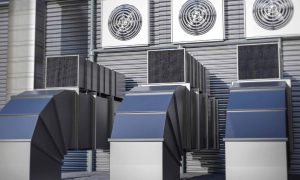Sharad Malga, Director at Remoda Technologies Pvt. Ltd., discusses how optimal air conditioning solutions for public spaces are required with the increasing population and highlights the role of temperature monitoring in cold chain logistics.
Which types of air conditioning equipment offer the best balance of affordability and efficiency in public spaces?
Every building or accommodating space requires a comfortable temperature, according to the occupants and the location. Multiple cooling options are available on the market, and choosing the correct one is imperative. Residential apartments have fewer occupants and can opt for energy-efficient split ACs or mini VRF/VRVs. Office spaces have cubical arrangements, so they can opt for VRV or VRF. Inverter ducting or package design systems can be chosen in open office spaces.
For malls, cineplexes, and hotels where the load is more than 100 TR, we should go for a modular design where water will run inside the pipes within the building, and refrigerant will be out of the building. This way is sustainable and efficient. If the load exceeds 200 TR, customers should consider opting for chillers. Multiple chiller ranges are available on the market, like the water-cooled screw chiller with VFD and the air-cooled screw chiller with VFD. Magnetic chillers have also been introduced to optimise the OPEX (operating expenses).
Why is accurate sensor data essential for ensuring the efficient operation of a system?
Installing an efficient system is just the first step; the ongoing monitoring and provision of accurate input indeed ensures optimal performance. Sensors play an important role in this process by constantly monitoring variables such as temperature, pressure, and humidity within the workspace. These sensors provide precise data to the system to maintain the ideal conditions for human comfort. The entire system is at risk of malfunctioning if these sensors falter, providing inaccurate or inconsistent readings. Such malfunctions disrupt operations while creating discomfort for end users. This highlights the importance of reliable sensor data in ensuring the smooth functioning of the system.
How have technological advancements in cooling systems improved energy efficiency and sustainability for supermarkets?
Supermarkets have a different cooling load profile compared to other commercial establishments. The load can vary hourly and is influenced by local geography. Therefore, the system should be optimised to handle the varying loads within the building. There were limited options in the past, such as packaged and ductable ACs. However, with technological advancements, equipment now comes with variable drives to manage varying building loads. Modular designs are also available on the market, which increases savings on operating expenses. These systems are designed to use water, ensuring that no refrigerant enters the building, which is a more sustainable approach. Conventional chillers have also been upgraded to magnetic designs to enhance operational expense savings.
In what ways do temperature-measuring instruments during transportation contribute to the safety of cold chain logistics?
India is a developing nation with constant and rapid growth. The transportation of cold-chain products has become a need now. When we consider the availability of products on a pan-India basis, there has been significant improvement, largely due to advancements in cold chain logistics. However, the maintenance of these logistics is essential for smooth daily operations.
Temperature-measuring instruments help monitor real-time data, allowing for preventive actions to avoid major equipment failures. Modern systems often come with IoT capabilities, improving monitoring and management. Proper data capture and storage are used to analyse system performance. This plays an important role in maintaining and improving cold chain logistics.
Incorporating predictive maintenance sensors into temperature monitoring systems for commercial HVAC equipment can significantly enhance energy efficiency. Given the widespread adoption of IoT-based platforms globally, integrating these sensors is vital. Despite the benefits, the installation and upkeep of such systems remain critical aspects for buildings. People tend to neglect maintenance after installing smart systems and resort to conventional methods of system operation, especially with HVAC systems. Therefore, while installing the system is essential, ensuring its proper operation and maintenance are equally critical.
Cookie Consent
We use cookies to personalize your experience. By continuing to visit this website you agree to our Terms & Conditions, Privacy Policy and Cookie Policy.












